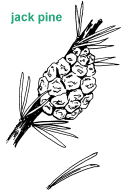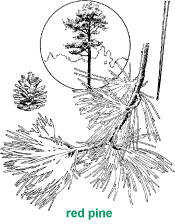
 |
  Dry pine forests include pure stands of jack pine and mixtures of jack, white, and red pine, northern pin oak, and aspen. These
communities, which
foresters collectively call dry conifers (evergreens) because pine is the key component, occur on dry, sandy soil that is
acidic and nutrient-poor.
Landscapes here are
typically high and flat. These forests also occur on sandy ridges within large wetland complexes and on steep, cobblestone ridges next to large sandy plains. Dry pine forests include pure stands of jack pine and mixtures of jack, white, and red pine, northern pin oak, and aspen. These
communities, which
foresters collectively call dry conifers (evergreens) because pine is the key component, occur on dry, sandy soil that is
acidic and nutrient-poor.
Landscapes here are
typically high and flat. These forests also occur on sandy ridges within large wetland complexes and on steep, cobblestone ridges next to large sandy plains.
Historically, this landscape was a shifting mosaic of forest and open grasslands, or "barrens," that was primarily maintained by wildfires of varying frequency and intensity. In the 1800’s, there were approximately 1.3 million acres of dry conifer forest in Michigan, with about 80 percent of the total found in the northern Lower Peninsula. Today, about 800,000 acres remain. They occur mostly in the high plains region from Mio to Vanderbilt east of I-75 and in flat, sandy areas of the Upper Peninsula. Perhaps more than any other single influence, the timber-cutting operations that occurred between the early 1800’s and early 1900’s changed the way these forests look today. Before the loggers arrived, red and white pine were often mixed within dry conifer forests. Large-diameter trees that had survived wildfires helped to form a complex forest that varied from young seedlings and saplings to large canopy trees. Other typical trees, shrubs, and groundcovers included balsam fir, black cherry, paper birch, sweetfern, blueberry, huckleberry, sand cherry, and bearberry. Bracken fern, poverty grass, Pennsylvania sedge, and hairgrass were other common plants. Loggers removed much of the favored red and white pine, and the fires that followed helped jack pine to regenerate over many more acres than before.
Areas with frequent fires, such as portions of Lake, Crawford, Iosco, and Oscoda counties, were dominated by jack pine barrens. The barrens were not wastelands, as the name suggests, but rather a unique grass-dominated ecosystem with only a few jack pine trees per acre. Because this system was so open, it admitted sunlight to reach the forest floor allowing a diverse understory of shrubs, grasses, and wildflowers to flourish. Shrubs found here include those from the adjacent forest, along with prairie willow and hazelnut. Today, fire suppression and the establishment of pine plantations have reduced the number of high-quality jack pine barrens to only a few hundred acres. Inappropriate off-road- vehicle (ORV) use, a boom in second-home development in northern Michigan, and the invasion of invasive plants are other reasons why this unusual ecosystem is losing ground. Today, only 100 acres of high quality barrens remain. Species PresentIf you own a jack pine forest that is a fragmented patchwork of grassy openings and woods, look for prairie-associated shrubs, grasses, and wildflowers growing in the openings and along the forest edges. Plants to look for include rough blazing star, prairie cinquefoil, birdfoot violet, butterfly weed, harebell, and hoary puccoon. In addition, hill's thistle, rough fescue, Alleghany plum, and pale agosersis are rare plants that live in jack pine barrens. Grasses include big bluestem, little bluestem, poverty grass, hair grass, June grass, and needle grass. The presence of these species suggests that a seed bank exists beneath the maturing forest canopy. These rare communities are an important part of Michigan's heritage. Through prescribed burning and possibly planting, you might be able to restore what was originally a special kind of prairie. See the section on Grassland Management for more information.
Common animals found throughout the dry conifer mosaic include the red crossbill, hermit thrush,
bluebird, red-tailed hawk, raven, American kestrel, coyote, snowshoe hare, and
black bear. Also, badgers, upland sandpipers, and
Management ConsiderationsSome type of disturbance, such as fire or timber harvest, is needed to maintain a jack pine forest. However, fire as a management technique has its perils. As a result, timber harvesting, often followed by artificial seeding or planting, is more commonly used in forest management. Professionals recommend either or both management techniques, especially for those property owners with 200 or more acres of dry conifer forest. The following are options to consider when managing dry conifers. Prescribed BurningIf used safely, fire is the most effective management tool, particularly if a composite of forest, barrens, and grassy openings is your objective. Also, fire is the common means by which jack pine forests are rejuvinated. Jack pine is unusually adapted to fire because their pine cones are coated with a resin that melts at 112 degrees F., a temperature normally reached only through fire. Once the resin melts, the cones open and thousands of seeds are released. Fire also decreases competition, reduces leaf litter on the forest floor, prepares a good seed bed for regeneration, and releases nutrients into the soil. Besides the positive influence on jack pines, fire maintains the variety of prairie grasses and flowers that are also dependent on fire for their survival. Consider conducting a controlled burn on any complex of forest, grasslands, and barrens that is at least 20 acres in size. Such areas should be burned at 10 to 20 year intervals. You may also want to consider burning after your forest is clearcut and then follow with seeding or planting with trees. Because of economies of scale, bigger burns are more appropriate and cheaper. Fire, as a tool, can be complex and dangerous. Rightly so, it is best left in the hands of a trained resource professional. Also, whenever prescribed fire is used as a management tool, you must work with your local fire officials to obtain permits and regulations. In many instances, the use of prescribed burning of jack pine forest is very limited on private lands, especially on smaller tracts. For more information, see the chapter on Prescribed Burning in the Grassland Management section. Timber HarvestingTimer harvesting produces many but not all of the same positive effects as fire. The Timber Harvesting chapter, located in the Forest Management section, explains several options to consider. Clearcutting is the preferred way for managing jack pine stands from 20 to 200 acres in size. In this scenario, young pine is promoted soon after the mature trees are cut.
To manage for other species of wildlife, it is best to cut in smaller blocks to produce a variety of age classes and densities. Such a system can be used to manage stands of jack pines as small as 80 acres by cutting 20 percent of the total (about 16 acres) every 10 years to give the entire stand as much diversity as possible. Make the cuts at least 100 yards wide and 300 yards long in a north-to-south direction whenever possible. Larger cuts are, of course, more economical when profitability is the goal. If you own 20 acres or less, cut all the jack pine at one time. Clearcuts that follow the topography of the land are preferred, as are irregularly-shaped cuttings instead of straight-sided block cuts. Leaving 20- to 40-foot-wide strips of mature trees between the harvests will minimize short-term disturbances to the site. Avoid trying to manage frost pockets (low areas that experience late spring frosts) because these low-lying areas do not respond well to clearcutting. Also, within each cutting area consider leaving small clumps of 10 to 20 white pines, oaks, or shrubs such as serviceberry and hazelnut because these species provide food and cover for wildlife. You can also increase cover for rabbits and other wildlife by making brush piles of at least 15 feet in diameter and five feet high from slash and other harvest debris. It is preferable in these areas to maintain only one brushpile for every five acres as too many rabbits will consume jack pine seedlings. Leave standing snags for cavity-nesting birds like woodpeckers and bluebirds, or put out nesting boxes. For more information, see the Homes for Wildlife chapter in the Backyard section. Remember, pine barrens are very rare and are home to several rare plants and insects. If you own a jack pine forest that is currently a highly fragmented patchwork of grassy openings and forest where prairie-associated shrubs, grasses, and forbs are found, you may have a former pine barren. You should consider restoring it through prescribed burning and selective timber harvest. In summary, dry conifer forests are a valuable part of Michigan's natural landscape. Pine barrens are a unique and uncommon ecosystem within the dry conifer spectrum. If you have a dry conifer forest on your property, you may have the opportunity to manage for many wildlife species, including several rare ones.
Last Revised: November 6, 1999 | ||||||||
|